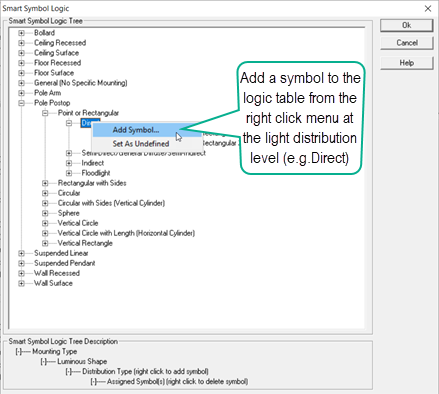
Smart Symbol Logic
The Smart Symbol Logic dialog provides the settings for the Smart Symbol selection in the Luminaire Define dialog. Modifications should only be undertaken with a thorough understanding of Smart Symbols. Any modifications are not overwritten when AGi32 is updated.
The Smart Symbol Logic dialog is displayed in a tree format. The format is outlined at the bottom of the dialog along with some basic instructions.

Symbols are assigned at the Distribution Type level by right clicking on the desired node (e.g., Direct) and selecting the Add Symbol option from the secondary menu. The Luminaire Calculation Symbols dialog is displayed and the symbol may be selected from any symbols folder. Color, Scaling Factors and Insertion point may not be modified at this time, they are specified when Smart Symbols are selected.
A Distribution Type may be allocated as undefined for a particular Mounting Type-Luminous Shape combination so that users are prompted to select a more appropriate mounting type. Right click on the Distribution Type node (e.g., Indirect) and select Set as Undefined from the secondary menu. No symbols should be defined for an undefined Distribution Type.
Some luminous shapes (such as Point, Rectangular and Rectangular with Sides) are common and it is desirable to have multiple symbols defined with varying length ratios. We recommend selecting symbols that have equal Length and Width (L = H), symbols that have Length greater than Width (L > W) and symbols with Length less than Width (L < W). Having at least one symbol selected for each of these options, ensures that the user will have an appropriate symbol to select for each photometric distribution. Symbol Characteristics
Distribution Type - Four distribution types are recognized by AGi32: Direct, Direct-Indirect (Semi-Direct, General Diffuse and Semi-Indirect), Indirect and Floodlight.
Luminous Area Type
- Point, Rectangular, Rectangular with sides, Vertical Rectangular
- Circular, Circular with sides (Vertical Cylinder), Horizontal Cylinder along length, Horizontal Cylinder along width
- Ellipse along length, Ellipse along width, Ellipsoid along length, Ellipsoid along width
- Sphere and Vertical Circle facing photometric horizontal
- If an unsupported luminous shape is encountered, no symbol will be available.
Luminous Box - A luminous box is inscribed from the luminous dimensions (Length, Width and Height) specified in the photometric file. The luminous area (white rendered appearance) of the symbols are scaled to match the luminous box dimensions.